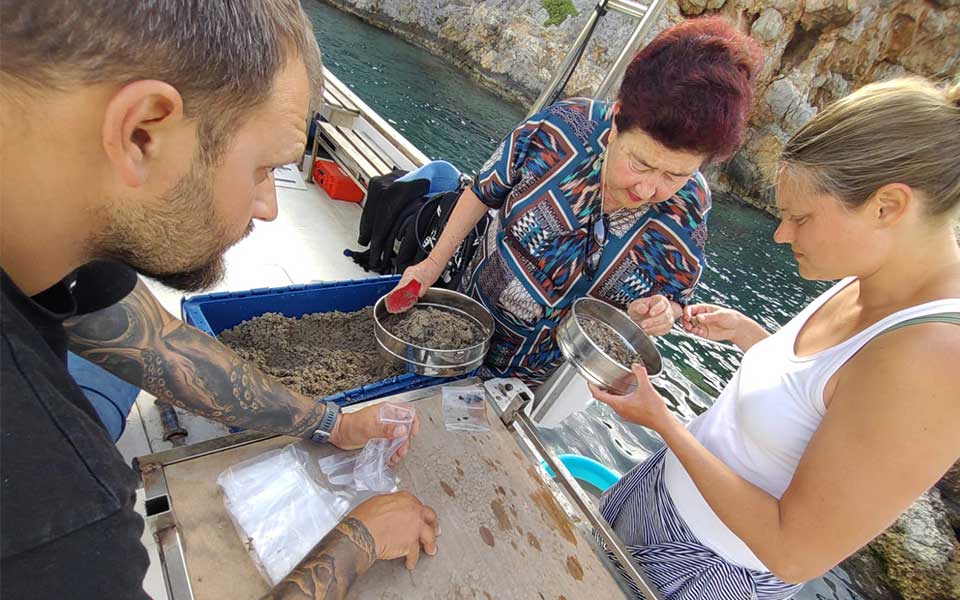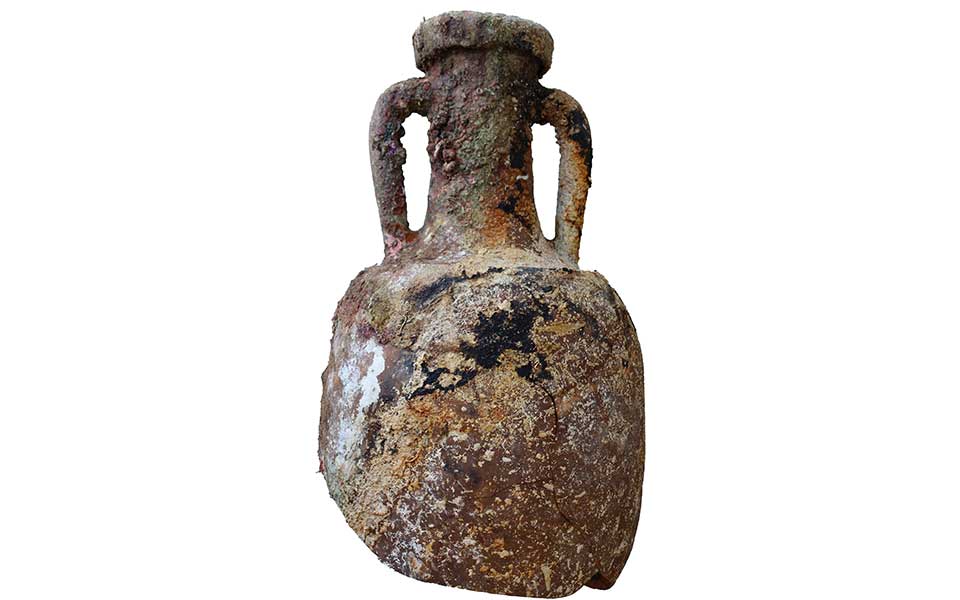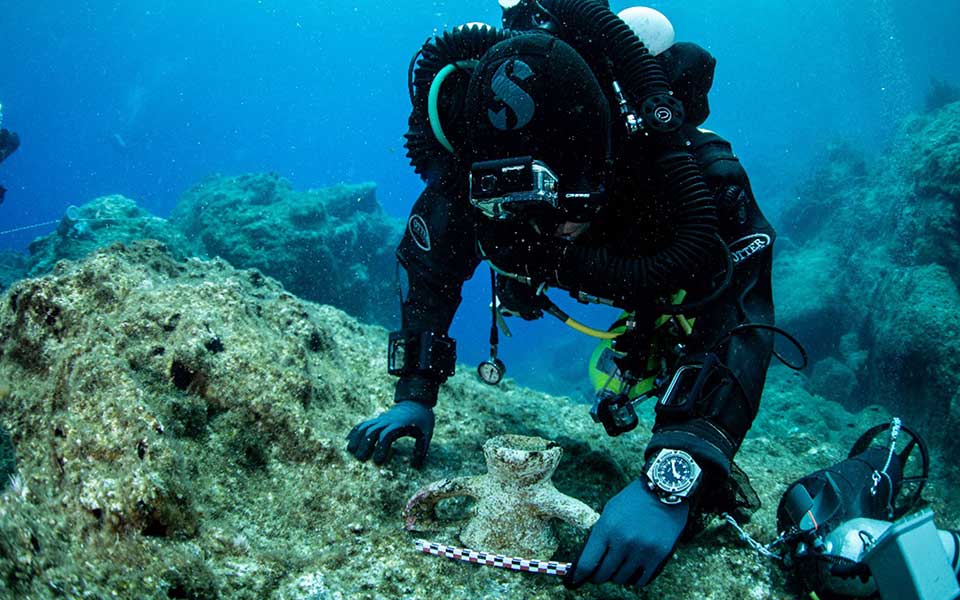This year, Poseidon seemed to favor the archaeologists, divers, and scientists working on the Antikythera mission, bestowing them with exceptionally calm weather. Since research at the site of the famous ancient shipwreck restarted in 2014, strong winds, sometimes reaching up to 11 on the Beaufort scale, have been a major obstacle to diving operations. This year, however, from May 17 to June 20, a true meteorological miracle occurred, enabling the team to proceed with the 2021-25 research program without interruptions. Dr. Angeliki Simosi, honorary director of antiquities at the Greek Ministry of Culture, and Dr. Lorenz Baumer of the University of Geneva, co-directors of the Swiss Archaeological School’s research under the Ephorate of Underwater Antiquities, both expressed their enthusiasm for the significant progress made in the field.
This season, the team managed to pinpoint the precise location of the remains of the wooden hull that carried the statues and the Antikythera Mechanism. This discovery is significant because it allows for more accurate estimations of the ship’s size and the location of the hold that transported the valuable cargo. Previous explorers, including the sponge divers from Symi in 1900 and Jacques Cousteau’s teams in 1953 and 1976, found scattered statues and other objects on the sloping seabed but missed the exact resting place of the Roman-era ship, which sank sometime in the second quarter of the 1st century BC. This new discovery will hopefully help the archaeologists understand why the ship sank, its course and heading, and possibly even the identities of its crew and passengers, as skeletal remains and teeth have been found in earlier seasons.
Moreover, this year revealed an even more astonishing discovery: archaeologists identified a deposit of pottery of the same type as that from the shipwreck about 200 meters away. Initially, it was unclear whether this indicated a second ship or if lighter objects had floated away in the currents during the sinking. This year’s findings confirmed the existence of another ship near the wreck, supporting the theory of two ships traveling together. However, it is still too early to draw definitive conclusions.

© Alexandra Sotiriou
Technological Advances and Methodology
Besides the favorable weather, technology also played a crucial role this season. The design and feedback processes were aided by the database and Geographic Information System (GIS) developed in previous years. Remotely operated vehicles (ROVs) from Hublot Xplorations and the Hellenic Coast Guard’s underwater missions unit enabled real-time monitoring and coordination of underwater operations. These tools were also used to create digital 3D models of selected areas, and special scanners developed by Swiss watchmaker Hublot’s research and development team produced three-dimensional models of the retrieved objects.
Seabed samples collected by divers were immediately processed in a micro-geoarchaeological laboratory set up on the island. These analyses are helping the researchers understand what happened to the ship, or convoy, when it sank around 60-70 BC. Instead of reaching its final destination fully loaded, it ended up in a small, harbor-less area of the coast that had once been a notorious pirate hideout. Furthermore, analyses of the contents of the ceramic amphorae retrieved from the seabed revealed key insights into the types of food and wine that were being transported.

© University of Geneva
Statue Fragments
This year’s discoveries include numerous statue fragments, ceramics, and wood from the hull. Among the 18 statue fragments found were two head fragments similar to previous finds, several fingers from at least two hands, two toes, a hand, and fabric fragments. As Professor Baumer noted last year in an interview with K Magazine: “You know, in our work, even the smallest fragment, like a nail, can provide us with significant information. It can help us understand exactly how the ship sank, where it came from, where it was headed, what else it was carrying, and who was on board. I assure you that these humble scraps are of the same invaluable worth as a statue.”
In these three short sentences, the Swiss Archaeology Professor encapsulated the entire spirit of the research, which has gained new momentum. Initially, this research started ten years ago because of the enormous success of the exhibition on the shipwreck and the Antikythera Mechanism at the National Archaeological Museum in Athens. The aim has been to find something impressive at the site, and the Swiss involvement has certainly added a new dimension to the project. The research is conducted patiently and scientifically, with a strategy to uncover the shipwreck’s secrets in a clear and methodical way.
The Swiss mentality, combined with the professionalism and expertise of Greek archaeologists and divers, has been vital. Swiss watchmaking company Hublot, along with the Aikaterini Laskaridis Foundation, personally supported by its president, Panos Laskaridis, funds the project. Hublot’s head of research and development, Mathias Buttet, and his team are so passionate about the Antikythera project that they dedicate much of their time to solving technical issues.
The dedication of all participants, the archaeologists and the divers who spent a month on a remote island under challenging conditions, is commendable. Overcoming all manner of adversities, their ongoing efforts are crucial in unraveling the mysteries of this shipwreck, which continues to captivate scientists and the public the world over. Not only did the ship carry the Antikythera Mechanism—an ancient computer with a complex gear system and a geocentric planetarium representing the irregular movements of the Sun, Moon, and the five known planets of antiquity—but each year, the story of this maritime disaster grows more fascinating.
This article was previously published in Greek at kathimerini.gr.












